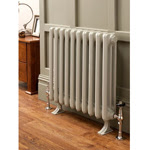The Victorians were the first to install radiators
in their homes but only those with plenty of money. The rest of the general
population had to wait until easy credit was offered in the nineteen–seventies.
Those early radiators were usually bulky
items and all made from cast iron. Some examples of these can still be found in
one or two cathedrals today and have been adapted to run on gas from their
original coal fired source.
The cathedral examples were typically
around ten foot tall and thirty feet in circumference and even half a dozen of
these were never enough to heat a Norman nave on a freezing Christmas Day.
Nearly all the radiators fitted in the
seventies were made from steel but in recent years a number of other metals and
alloys have been used.
The design of radiators has also changed dramatically
in the past few years and there are many exciting shapes and sizes that hung on
a wall without exposed pipework could easily be taken as works of contemporary
art.
With steel, aluminium, chrome and even
mirror effect radiators it should perhaps come as no surprise to discover that cast iron radiators are also in
fashion. These retro looking examples are perfectly suited to period properties
of the Victorian and Edwardian era.
The fact that there are so many different
types of radiator now available to us all means that they have become an
integral part of any property makeover. Old systems let down property
refurbishments often just because of the old looking radiator as well as yards
of exposed pipework along skirting boards and walls.
New systems try to hide as much of the
pipework as possible and this is important with maintaining the impact of new
radiators.
When ordering new radiators online don’t
forget about valves. Valves do not come as standard because there is no such
thing when it comes to fitting the radiator. You must decide from the angle the
pipe meets the bottom of the radiator on whether straight or angled is
required.



No comments:
Post a Comment